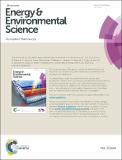Enhanced charge carrier mobility and lifetime suppress hysteresis and improve efficiency in planar perovskite solar cells
Author(s)
Nienhaus, Lea; Bawendi, Moungi G; Correa-Baena, Juan-Pablo
DownloadAccepted version (1.406Mb)
Terms of use
Metadata
Show full item recordAbstract
Perovskite solar cells (PSCs) are very promising lab-scale technologies to deliver inexpensive solar electricity. Low-temperature, planar PSCs are of particularly interest for large-scale deployment due to their inherent suitability for flexible substrates and potential for silicon/perovskite tandems. So far, planar PSCs have been prone to large current-voltage hysteresis and low stabilized power output due to a number of issues associated with this kind of device configuration. We find that the suppression of the yellow-phase impurity (∂-FAPbI3) present in formamidium-based perovskites, by RbI addition, contributes to low hysteresis, higher charge carrier mobility, long-lived carrier lifetimes and a champion stabilized power output of 20.3% using SnOx as the electron selective contact. We study the effects of these impurities on the transient behavior that defines hysteresis and its relation to ionic movement. In addition, we find that the formation of a RbPbI3 phase does not significantly affect the charge carrier lifetimes and consequently the performance of the devices. This brings new physical insights onto the role of different impurities in perovskite solar cells, which make these materials so remarkable.
Date issued
2017-12Department
Massachusetts Institute of Technology. Department of Chemistry; Massachusetts Institute of Technology. Department of Mechanical EngineeringJournal
Energy and Environmental Science
Publisher
Royal Society of Chemistry (RSC)
Citation
Turren-Cruz, Silver-Hamill, et al., "Enhanced charge carrier mobility and lifetime suppress hysteresis and improve efficiency in planar perovskite solar cells." Energy and Environmental Science 10, 1 (Dec. 2017): doi 10.1039/C7EE02901B ©2017 Author(s)
Version: Author's final manuscript
ISSN
1754-5706